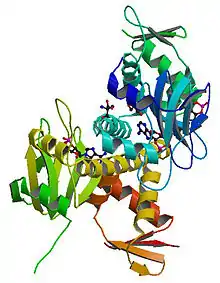cAMP receptor protein
cAMP receptor protein (CRP; also known as catabolite activator protein, CAP) is a regulatory protein in bacteria. CRP protein binds cAMP, which causes a conformational change that allows CRP to bind tightly to a specific DNA site in the promoters of the genes it controls.[1][2] CRP then activates transcription through direct protein–protein interactions with RNA polymerase.[1][2]
| CAMP receptor protein | |||||||
|---|---|---|---|---|---|---|---|
 Structure of the E. coli Cyclic AMP Receptor Protein. | |||||||
| Identifiers | |||||||
| Symbol | CRP | ||||||
| Alt. symbols | CAP | ||||||
| NCBI gene | 947867 | ||||||
| PDB | 1I5Z | ||||||
| RefSeq | NP_417816.1 | ||||||
| UniProt | P0ACJ8 | ||||||
| |||||||
The genes regulated by CRP are mostly involved in energy metabolism, such as galactose, citrate, or the PEP group translocation system.[3][4] In Escherichia coli, cyclic AMP receptor protein (CRP) can regulate the transcription of more than 100 genes.
The signal to activate CRP is the binding of cyclic AMP. Binding of cAMP to CRP leads to a long-distance signal transduction from the N-terminal cAMP-binding domain to the C-terminal domain of the protein, which is responsible for interaction with specific sequences of DNA.[5]
At "Class I" CRP-dependent promoters, CRP binds to a DNA site located upstream of core promoter elements and activates transcription through protein–protein interactions between "activating region 1" of CRP and the C-terminal domain of RNA polymerase alpha subunit.[1][2][6] At "Class II" CRP-dependent promoters, CRP binds to a DNA site that overlaps the promoter -35 element and activates transcription through two sets of protein–protein interactions: (1) an interaction between "activating region 1" of CRP and the C-terminal domain of RNA polymerase alpha subunit, and (2) an interaction between "activating region 2" of CRP and the N-terminal domain of RNA polymerase alpha subunit.[1][2] At "Class III" CRP-dependent promoters, CRP functions together with one or more "co-activator" proteins.[1][2]
At most CRP-dependent promoters, CRP activates transcription primarily or exclusively through a "recruitment" mechanism, in which protein–protein interactions between CRP and RNA polymerase assist binding of RNA polymerase to the promoter.[1]
References
- Busby S., Ebright RH. (1999). "Transcription activation by catabolite activator protein (CAP)". J. Mol. Biol. 293 (2): 199–213. doi:10.1006/jmbi.1999.3161. PMID 10550204.
- Lawson CL, Swigon D, Murakami KS, Darst SA, Berman HM, Ebright RH (2004). "Catabolite activator protein: DNA binding and transcription activation". Curr. Opin. Struct. Biol. 14 (1): 10–20. doi:10.1016/j.sbi.2004.01.012. PMC 2765107. PMID 15102444.
- Weickert MJ, Adhya S (1993). "The galactose regulon of Escherichia coli" (PDF). Mol. Microbiol. 10 (2): 245–51. doi:10.1111/j.1365-2958.1993.tb01950.x. PMID 7934815.
- Bott M (1997). "Anaerobic citrate metabolism and its regulation in enterobacteria". Arch. Microbiol. 167 (2–3): 78–88. doi:10.1007/s002030050419. PMID 9133329.
- Popovych, N.; Tzeng, S. -R.; Tonelli, M.; Ebright, R. H.; Kalodimos, C. G. (2009). "Structural basis for cAMP-mediated allosteric control of the catabolite activator protein". Proceedings of the National Academy of Sciences. 106 (17): 6927–6932. doi:10.1073/pnas.0900595106. PMC 2678429. PMID 19359484.
- Hudson, B. P.; Quispe, J.; Lara-Gonzalez, S.; Kim, Y.; Berman, H. M.; Arnold, E.; Ebright, R. H.; Lawson, C. L. (2009). "Three-dimensional EM structure of an intact activator-dependent transcription initiation complex". Proceedings of the National Academy of Sciences. 106 (47): 19830–19835. doi:10.1073/pnas.0908782106. PMC 2775702. PMID 19903881.